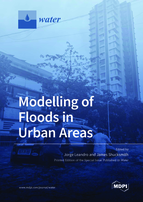Modelling of Floods in Urban Areas
A special issue of Water (ISSN 2073-4441). This special issue belongs to the section "Urban Water Management".
Deadline for manuscript submissions: closed (31 December 2020) | Viewed by 53406
Special Issue Editors
Interests: urban hydrology; urban resilience; rainfall-runoff modelling; flood inundation modelling; flood forecasting; calibration
Special Issues, Collections and Topics in MDPI journals
Interests: physical processes associated with urban flooding; model validation and uncertainty quantification; pollutant transport in river and urban catchments
Special Issue Information
Dear Colleagues,
Understanding the risk of flooding in urban areas is a societal priority. However, there are significant technical challenges associated with the appropriate charaterisation and representation of the numerous complex physical and hydrodinamic processes envolved.
The aim of this Special Issue is thus to publish the latest advances and developments concerning the modelling of flooding in urban areas and contribute to our scientific understanding of the flooding procceeses and the appropriate evaluation of flood risk.
It is anticipated that this issue will contain contributions of novel methodologies including (but not limited to) flood forecasting methods, data acquisition techniques, experimental research in urban drainage systems and/or sustainable drainage systems and new numerical approaches.
We further encourage the submission of original research, synthetic reviews or case study papers applying numerical or experimental modelling techniques in order to study the following topics:
Shallow overland flows over urban terrains
Flood forecasting
Evaluation of urban flood risk
Drainage system/surface flow interactions
Calibration and validation
Uncertainty quantification
The accepted papers will be published as open access ensuring widespread availability.
Dr. Jorge Leandro
Dr. James Shucksmith
Guest Editors
Manuscript Submission Information
Manuscripts should be submitted online at www.mdpi.com by registering and logging in to this website. Once you are registered, click here to go to the submission form. Manuscripts can be submitted until the deadline. All submissions that pass pre-check are peer-reviewed. Accepted papers will be published continuously in the journal (as soon as accepted) and will be listed together on the special issue website. Research articles, review articles as well as short communications are invited. For planned papers, a title and short abstract (about 100 words) can be sent to the Editorial Office for announcement on this website.
Submitted manuscripts should not have been published previously, nor be under consideration for publication elsewhere (except conference proceedings papers). All manuscripts are thoroughly refereed through a single-blind peer-review process. A guide for authors and other relevant information for submission of manuscripts is available on the Instructions for Authors page. Water is an international peer-reviewed open access semimonthly journal published by MDPI.
Please visit the Instructions for Authors page before submitting a manuscript. The Article Processing Charge (APC) for publication in this open access journal is 2600 CHF (Swiss Francs). Submitted papers should be well formatted and use good English. Authors may use MDPI's English editing service prior to publication or during author revisions.
Keywords
- floods
- urban drainage
- surface flow
- shallow water equations
- calibration
- validation
- flood forecasting
- uncertainty







